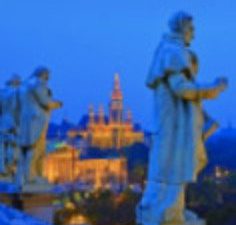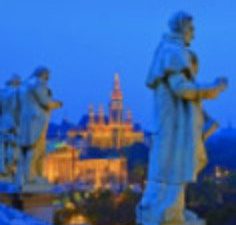Class act
April 30, 2017

Jet lag has me wide awake at 4:30 AM, but for once I’m not annoyed, because this is my opportunity to explore a city that many consider one of the most beautiful and civilized in the world. By 5:30 I’m walking down the Austrian capital’s Ringstrasse towards the Donaukanal, once a broad bend in the Danube but now a regulated water channel that marks the northeast corner of Vienna’s old city center.
I turn left to wander along its banks, lined with alfresco bars and cafés that, pre-dawn, are locked and lifeless, but during summer evenings buzz and bustle with city folk enjoying the balmy weather. The sky lightens as sunrise approaches, revealing artistic, colorful graffiti on the brick walls beside the canal. Early workers cycle past on clearly marked bike lanes and coffee houses are already open for breakfast and doing good business – Vienna’s famed kaffeekultur (coffee culture) is a way of life here.
The streets are now crowded with people going to work and taking kids to school, but there’s not a single raised voice from a peeved child or irate commuter – all is orderly and calm. I emerge onto Sigmund Freud Park opposite the towering neo-Gothic Votive Church, its sharp twin spires piercing the clear blue sky. I follow the tram tracks past an impressive university building to Rathauspark, which sprawls out before the grand City Hall. Built between 1872 and 1883, it has an even more ornate façade than the famed Burgtheater across the road – Europe’s second-oldest theatre and home to the Austrian National Theatre.
Even my accommodation – the Palais Hansen Kempinski Vienna – is in a heritage-listed building. Built for the World Exhibition in 1873, it was leased to Kempinski in 2010; its three courtyards were given glass ceilings and have become the refined lobby lounge, Die Küche breakfast café and a multipurpose event space. As I munch on hearty Austrian bread and a sampling from the superb breakfast buffet selection, I contemplate the architectural beauty of the city.
Preserving the Past
The Vienna Historic Preservation Commission was created in 2003, and it designated the Innere Stadt (First District) as the Central Historic District, with a ordinance put in place to stop any modern building or alteration of existing façades. The result is a de facto open-air museum of glorious architectural treasures, from Gothic to Baroque, Renaissance to Neoclassical. It is of course a UNESCO World Heritage site in its entirety. In 2014, 6.2 million people visited Vienna – a lot for a small city of only 1.8 million people – and for most of their sojourn the majority of them stayed within the Ringstraße, a generous boulevard that replaced the old city walls and today forms the First District’s circular border.
I do much the same; over the course of two days – which I advise is far too short a time to fully appreciate this most cultured of cities – I crisscross and circumnavigate the historic district, by myself and on guided tours. At just over a square mile it’s manageable on foot, but I buy a Vienna Card, which provides free travel on the underground, buses and trams for 48 hours (€21.90/$23) or 72 hours (€24.90/$27), as well as discounts for many of the top sights and tours, plus shopping and dining deals (wienkarte.at).
I visit the Vienna State Opera, one of the world’s most distinguished music venues, which was built in the mid-19th century and restored after being damaged in WWII. For those who can’t afford to buy a ticket, a huge screen on the side of the building streams live performances in the evening for everyone, with chairs provided – such is the city’s artistic altruism. I wander down history-rich streets past the Albertina museum, once a royal Habsburgs palace, then the Hotel Sacher, home of sachertorte (the world’s most famous chocolate cake), before heading to the center of the Innere Stadt, St Stephen’s Cathedral.
Most people stop in St Stephen’s Square for a few minutes to stare in awe at the Gothic splendor of this 700-year-old masterpiece. The South Tower, built in 1433, shoots up, lance-like, 446 feet into the sky, but the North Tower was unfinished and in 1579 was capped by a Renaissance dome, which gives it a peculiar appearance but doesn’t diminish its majestic stature over the Renaissance and Baroque city crowding around it.
Graben, a storied and now pedestrianized and café-strewn thoroughfare, leads from St Stephen’s Square west towards Kohlmarkt, another famous street lined with historic shops proudly displaying the royal insignia to show their status as purveyors to the crown.
At the end of Kohlmarkt is the Hofburg, the Imperial Palace. This grand set of buildings was the center of the huge Habsburg Empire, which ruled Central Europe from the 13th century right through to the early 20th century. It is home to the Sisi Museum in the Imperial Apartments, the renowned Spanish Riding School where beautiful white Lipizzaner horses dance an equine ballet, and a host of other museums, libraries, chapels and historical treasures.
Gemütlichkeit Abounds
I stroll past the rose bushes of Volksgarten (the people’s garden) to lunch at Café Landtmann, next to the Burgtheater. One of the city’s most famous and elegant coffee houses, it opened in 1873 and was frequented by the likes of Sigmund Freud, Gustav Mahler, Marlene Dietrich and, more recently, Hillary Clinton. Coffee houses in Vienna are renowned for their atmosphere of relaxed sophistication, where the concept of gemütlichkeit – roughly translating to mean a state of warmth, friendliness and good cheer – that’s so unique it has been given its own place on UNESCO’s Intangible Cultural Heritage list.
On my second day I venture outside the Ring Boulevard to Naschmarkt, a classic Viennese market just south of the Ring Road, where you can buy and eat food from a wide range of countries, and purchase clothes, souvenirs and other sundries. I stop by the grandiose Art History Museum and Natural History Museum, which face each other across a green, landscaped plaza. A short walk away is a famous statue of Mozart, and a short tram ride on Line 1 to the Stadtpark (City park) brings me to two more statues of famous residents: first Beethoven, looking pensive in his own small square, then Johann Strauss II, Vienna’s favorite son, depicted in gold playing his violin like a virtuoso.
Vienna is the only capital city in the world that produces a significant amount of wine within its city limits. In the evening I drive 20 minutes out of town to Weingut Mayer am Pfarrplatz, one of the city’s many vineyard heurigers, courtyard taverns where local winemakers serve their produce along with substantial meals of grilled meat, sausages, breads and desserts.
Surrounded by friends singing old folk tunes to an accordion’s jolly jig, chattering couples and families of all ages, seated at replete with wholesome food and fruity wine, I promise myself I’ll return to Vienna. Only next time my wife will come too, and we’ll stay longer. And perhaps we’ll come in winter, when the city’s famous Christmas markets in Rathaus Platz and St Stephen’s Square will provide the sort of gemütlichkeit that has charmed me during my short visit.
MEETING IN VIENNA
From the beautiful blue Danube to its traditional coffee shops and its splendid architectural legacy, Vienna retains an old world charm, a rich cultural sensibility and a long history. For visitors, Vienna is compact, green, safe and easily accessible, attributes which placed it at the top spot in Mercer’s 2016 Quality of Living Survey as the most livable city in the world. It was also named the World’s Most Reputable City in 2014 by the Reputation Institute.
All these accolades no doubt contribute to the Austrian capital’s consistent showing among the most popular meetings and convention destinations on the planet. Statistics from the International Congress and Convention Association rank Vienna fourth globally in 2015; in total Vienna hosted 3,685 congresses and conferences, company meetings and incentives, just under 750 of which were international.
The city has a wide range of venues large and small, along with attractions that offer interesting activities for attendees. According to the Vienna Convention Bureau, the city has three convention centers, 93 conference hotels, 34 historical venues and 17 contemporary locations.
Most of the key venues and hotels are located in the city’s first district, the central area encircled by the Ring Boulevard and on the south bank of the Danube Canal. To simplify travel for convention visitors, discount tickets for the Wiener Linien public transportation network, complimentary maps and information packs are available from the Convention Bureau.
More than three-quarters of convention travelers arrive by air, so the capital’s two largest conference centers recently installed self-service check-in kiosks to help cut travel time. The kiosks are available at Austria Center Vienna and the Messe Wien Exhibition & Congress Center to allow passengers flying with Austrian Airlines, Lufthansa, Swiss and Brussels to check in and print out their boarding passes on site.
To See and Do
Art and classical music are the cultural soul of the city, so Vienna boasts more than 100 museums, 27 palaces, 120 concert halls and theatres many of which offer magnificent spaces to host events. Among them, The Belvedere, a former baroque palace, now split into two museums and the Albertina includes 21 neoclassical Habsburg State Rooms and a collection which spans masters from Monet to Picasso.
The 16th-century Spanish Riding School is a meeting venue that also happens to be home to the snow-white Lipizzaner stallions. Hofburg, another first district venue, is the former winter residence of the Habsburg family, a labyrinthine venue for large-scale events, with 35 spaces overall.
Then there’s the city’s devotion to good food and drink, with around 7,400 cafés, bars and restaurants. And let’s not forget its passion for music and the arts – unsurprising given this was the home of Mozart, Beethoven, Haydn, Schubert and the Strauss family, as well as playwright Arthur Schnitzler and artist Gustav Klimt, among many others.
By Jeremy Tredinnick




